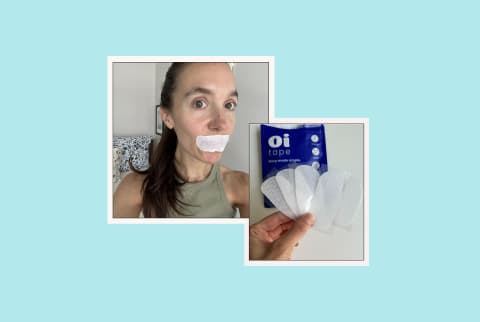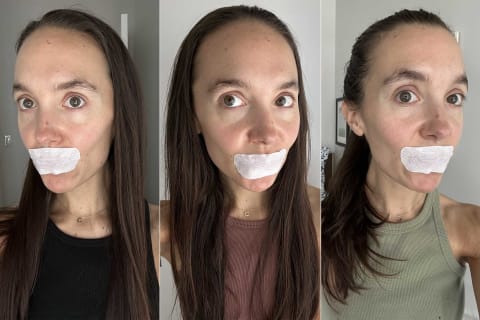Advertisement
This ad is displayed using third party content and we do not control its accessibility features.

June 15, 2024
We carefully vet all products and services featured on mindbodygreen using our
Our selections are never influenced by the commissions earned from our links.
I’m a bit of a sleep snob, but can you blame me? Sleep impacts your energy levels, heart health, metabolism, mood1, and even your skin. And no exaggeration: My entire day changes when I log quality shuteye.
I’ve spent years perfecting my sleep habits, and I’m obsessed with trying all the latest sleep hacks to determine which is worth the hype.
I don’t write about all my sleep experiments—but after one full week of testing Oi mouth tape for better sleep, my results were too good not to share. Keep reading to learn more about the viral mouth taping trend, what experts say, and my own experience.
Oi Tape™
Non-Vented Mouth Tape
$28

What is mouth tape?
Mouth tape is fairly self-explanatory: It’s the practice of gently taping your mouth shut while you sleep to encourage breathing through your nose.
Experts say changing to nasal breathing helps ensure that you are delivering the appropriate amount of oxygen to the body and can improve circulation and promote healthy blood pressure.
Does mouth taping work?
Chances are you’ve seen people on social media completing their bedtime routine by placing a thin piece of tape over their mouth, swearing that it helps improve their sleep. But what do science and experts say?
According to James Nestor, New York Times bestselling author of Breath: The New Science of a Lost Art, 60% of people mouth breath to come extent—and this can be detrimental to your sleep quality. That’s because when you breathe through your mouth, you’re bypassing your body’s natural buffer system by not properly using your nose.
Dentists have also recommended mouth taping for improving your oral microbiome, with studies suggesting mouth breathing can have a negative impact on your dental hygiene5.
Potential benefits of mouth tape
- Increase in rapid eye movement (REM) sleep
- Quieter sleep
- Improved dental hygiene
My week of sleep with Oi Tape
I first learned about mouth taping a few years ago, and I wasn’t sure how much of an impact it would have on my own sleep. I’m not a noisy sleeper, and I don’t have any glaring dental hygiene concerns.
As you may have guessed, I track my sleep religiously with my Oura ring—and my sleep scores are generally in the 80-90 range. I have had a few struggles with achieving enough REM sleep and deep sleep, which was the main concern I hoped to address.
After a lot of research on the best mouth tape for sleep, I landed on Oi tape, a gentle, BPA-free option that’s made without parabens of phthalates.
The brand offers vented or non-vented mouth tape, and I opted for the non-vented because I was fairly certain I already did most of my nighttime breathing through my nose.
Editor’s tip:
If you’re just beginning to experiment with mouth tape, experts suggest easing into the practice by using the tape vertically at first, moving to a vented option horizontally, and then a non-vented option if you prefer. It can also be helpful to try a few breathing exercises to relax your body and mind before applying the tape.
I slept with mouth tape every night for one week straight, and at first, I thought the results were a fluke. I had been experiencing lower sleep scores for a few weeks after being sick, but the morning after my first mouth tape experiment, my score shot up over 10 points.
To my surprise, my sleep score did not dip below a 90 the entire rest of the week. What really shocked me, though, was the difference I saw in my REM and deep sleep, along with the amount of movement I experienced throughout the night.
I tend to fall asleep very quickly (a sign your body could be overtired), but I often remain in a light, restless sleep for a long time before settling. As you’ll see in my before (above) and after (below) photos, I ended the week with a 95 sleep score and more than an hour of additional deep sleep.
Plus, I had a much more normal latency (the time it takes to fall asleep), indicating that even just a week with this new habit helped my body recover to a less fatigued state.
Of course, great sleep scores mean nothing if you don’t feel great, too. Throughout my week of testing, I felt more energized, my mood was better, and I was spending way less time lazing around in bed after waking up.
What I love about Oi Tape
To answer the question you’re likely wondering: Yes, you could just grab any old tape and place it over your mouth—but I’m so glad I tried Oi Tape specifically.
- It’s way more comfortable than any DIY option.
- The BPA-free material does not contain any parabens or phlalates.
- The wide design comfortable covers mouths of all shapes and sizes.
- It isn’t painful to remove or readjust.
- It stays on throughout the night.
- It’s durable and high-quality, but affordable.
- The results are evident in my sleep scores and how I feel.
Oi Tape™
Non-Vented Mouth Tape
$28

The takeaway
I’ll try just about anything to improve my sleep, but I won’t stick with a habit unless it actually works.
This Oi mouth tape helped me spend more time in deep sleep and REM sleep—and I’m feeling the impact every day. The best part? It costs way less than most of my favorite sleep tools.



